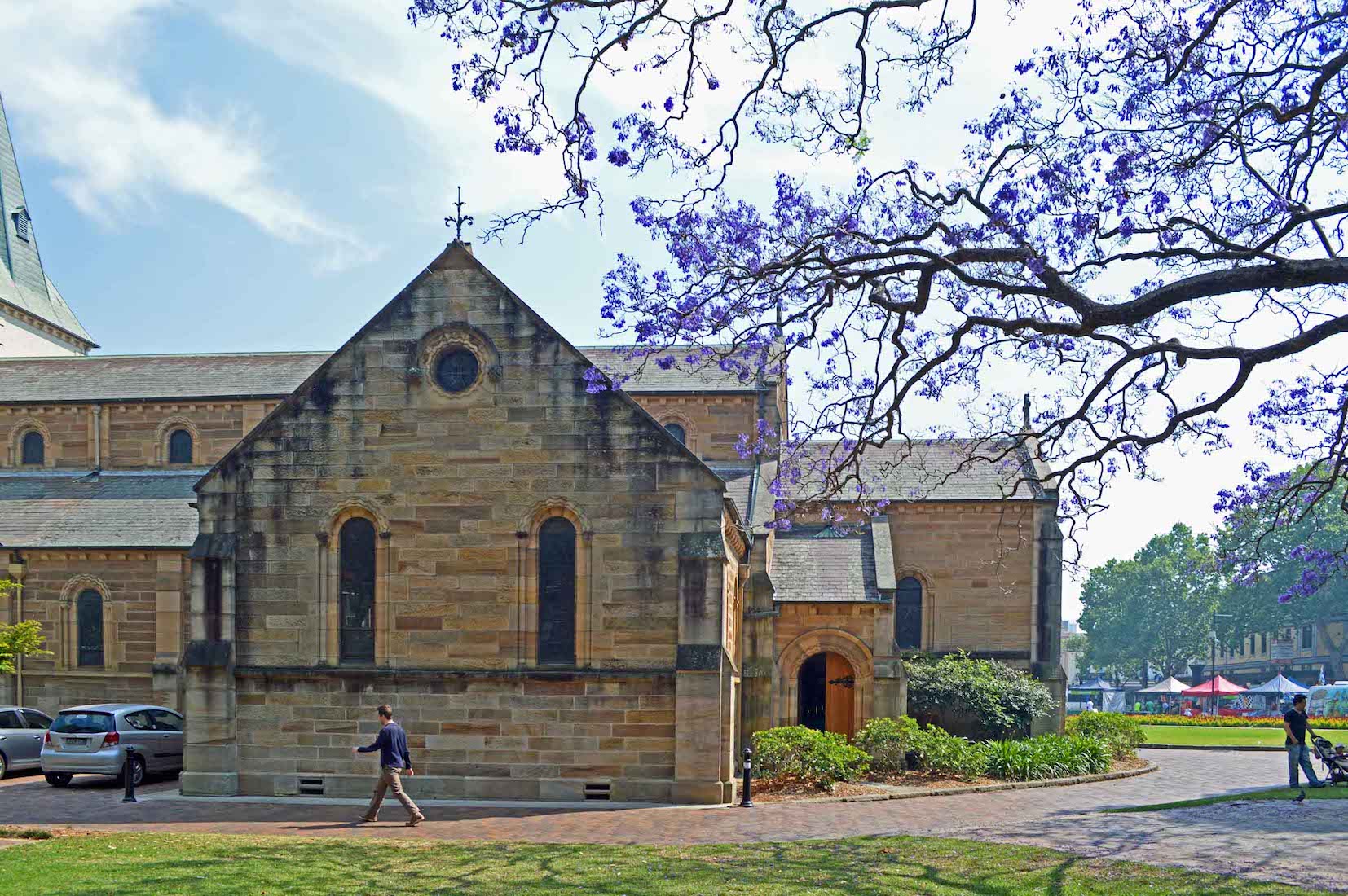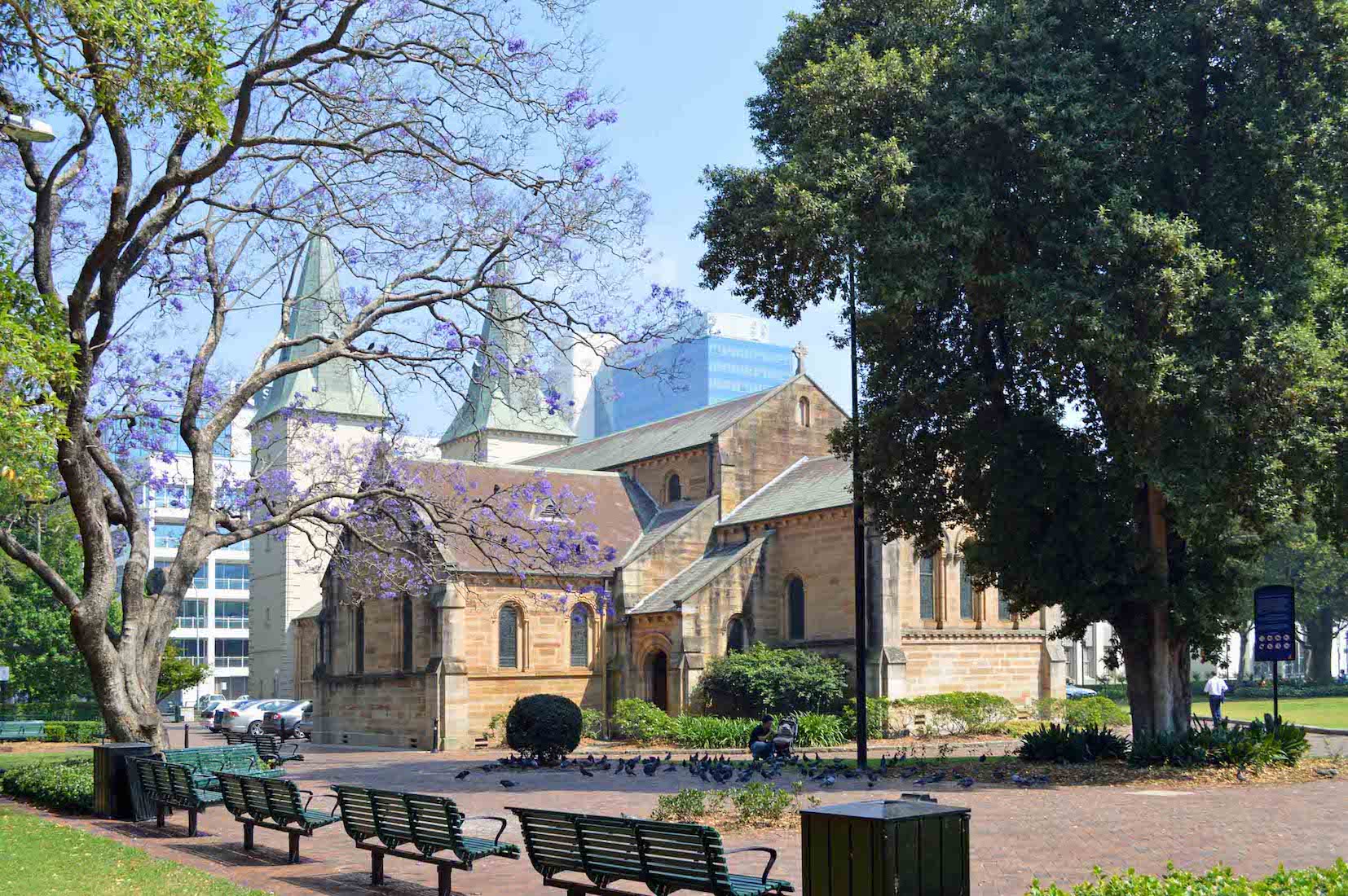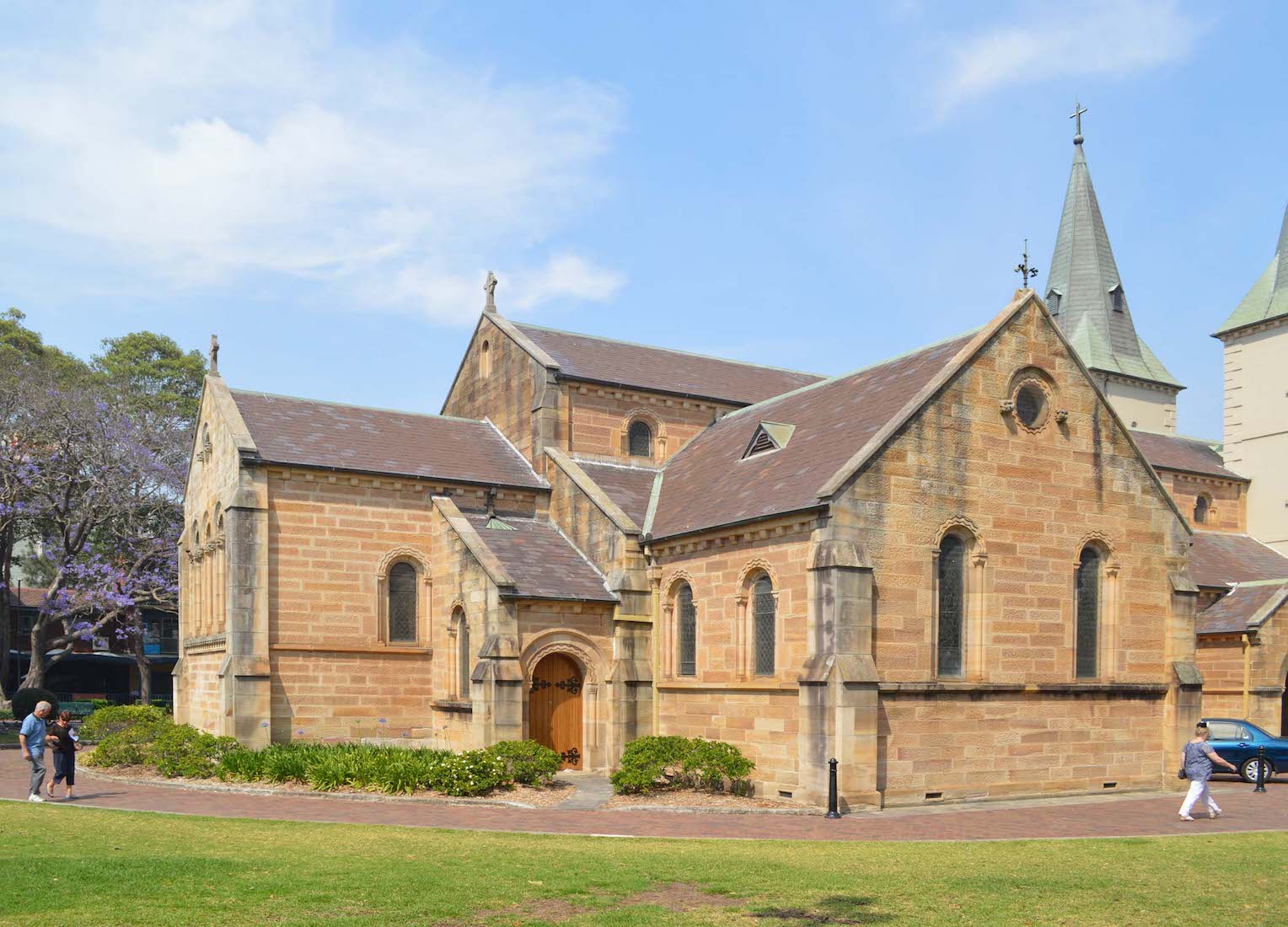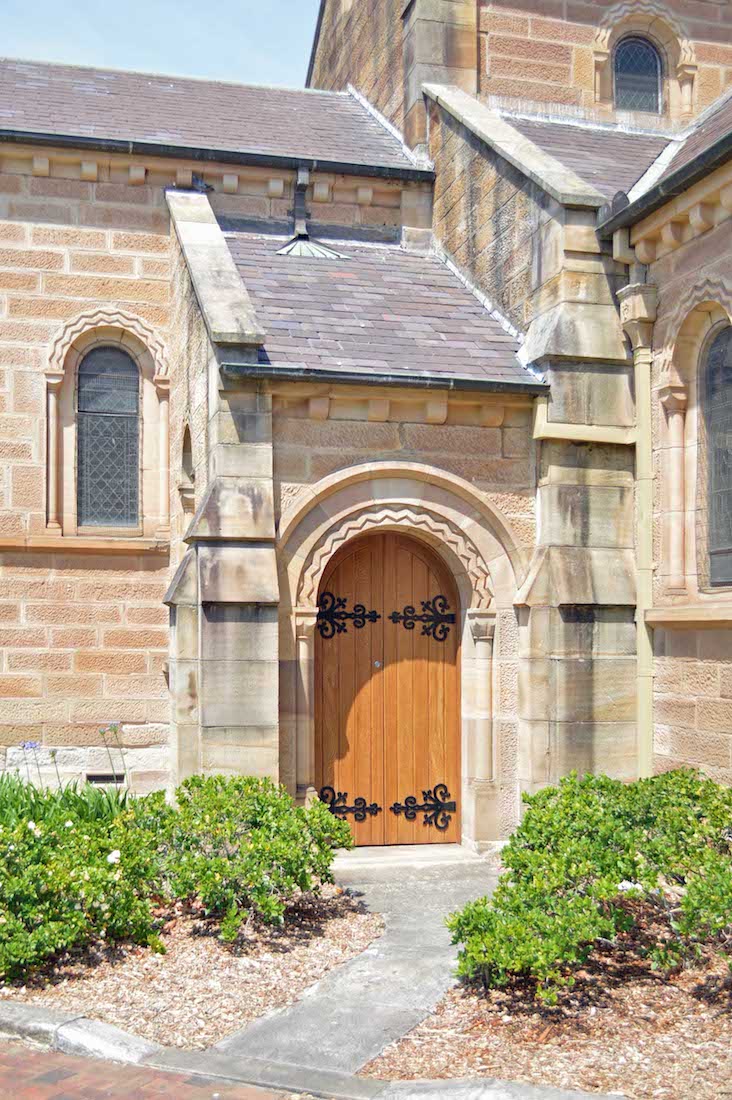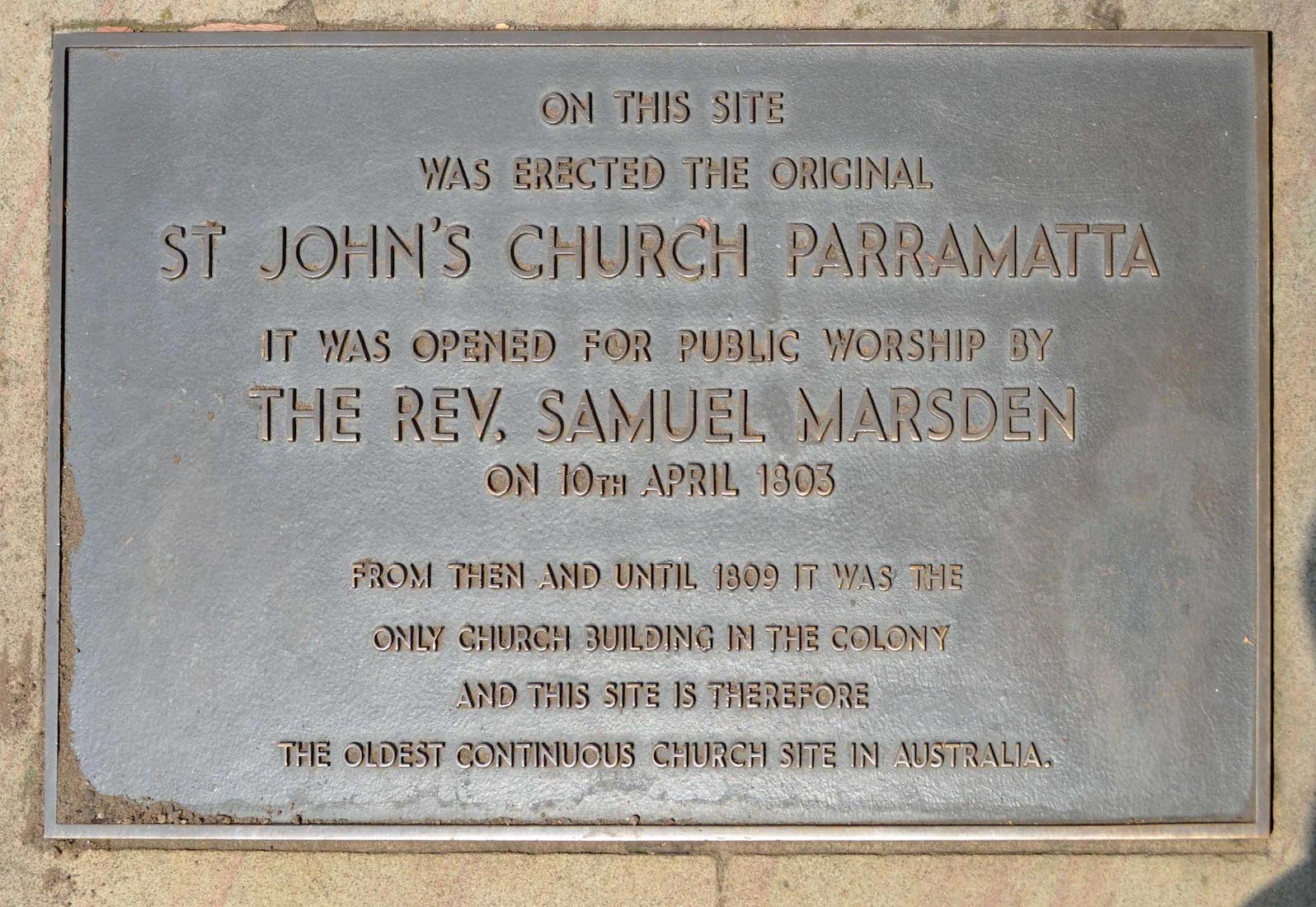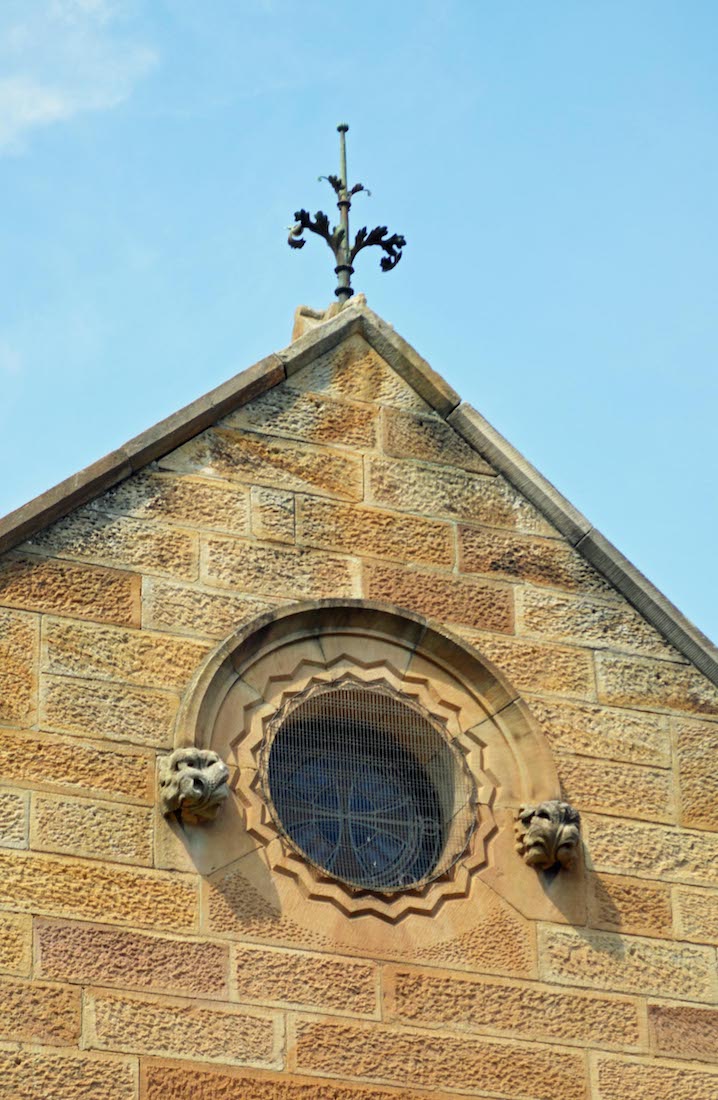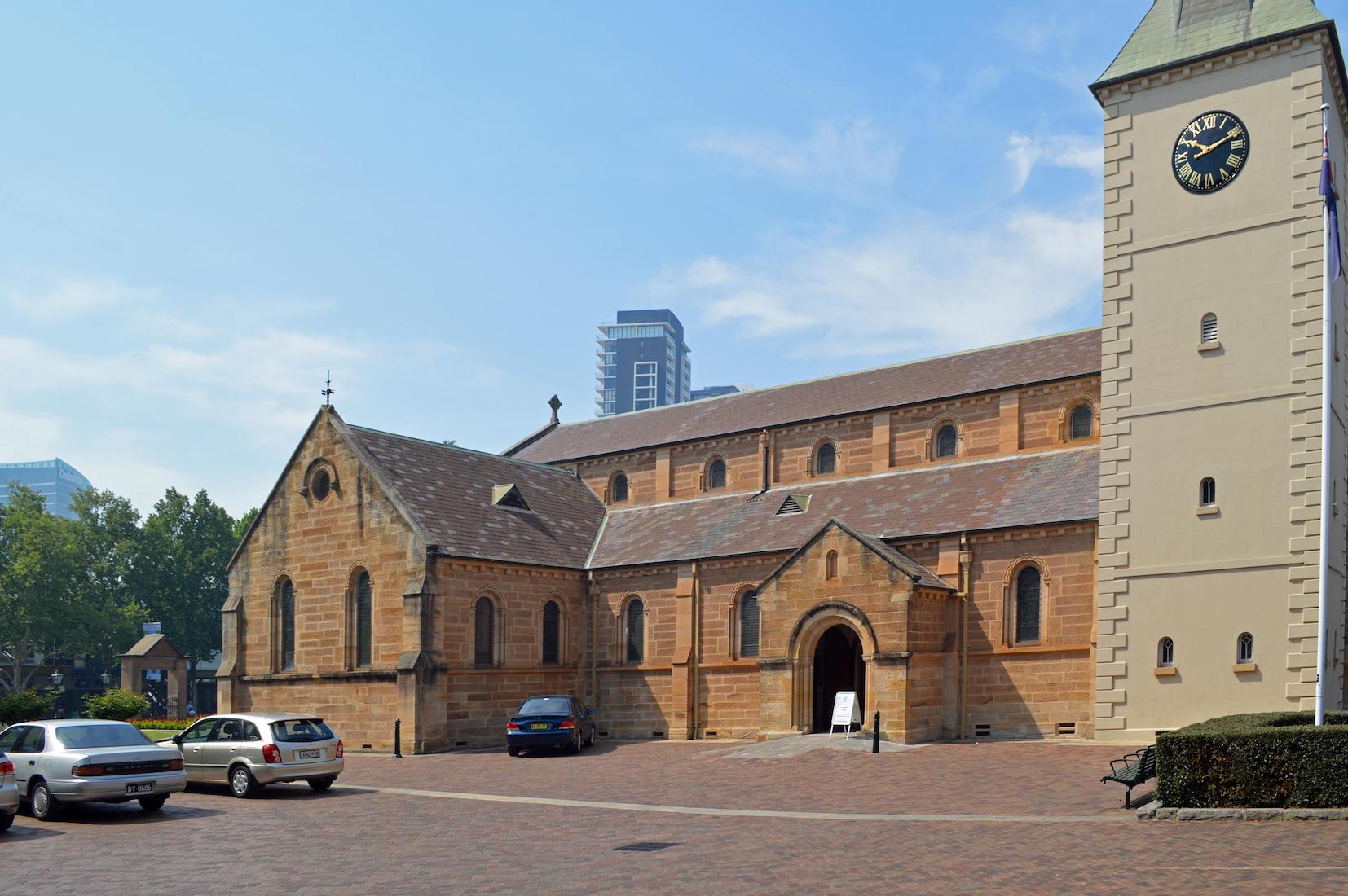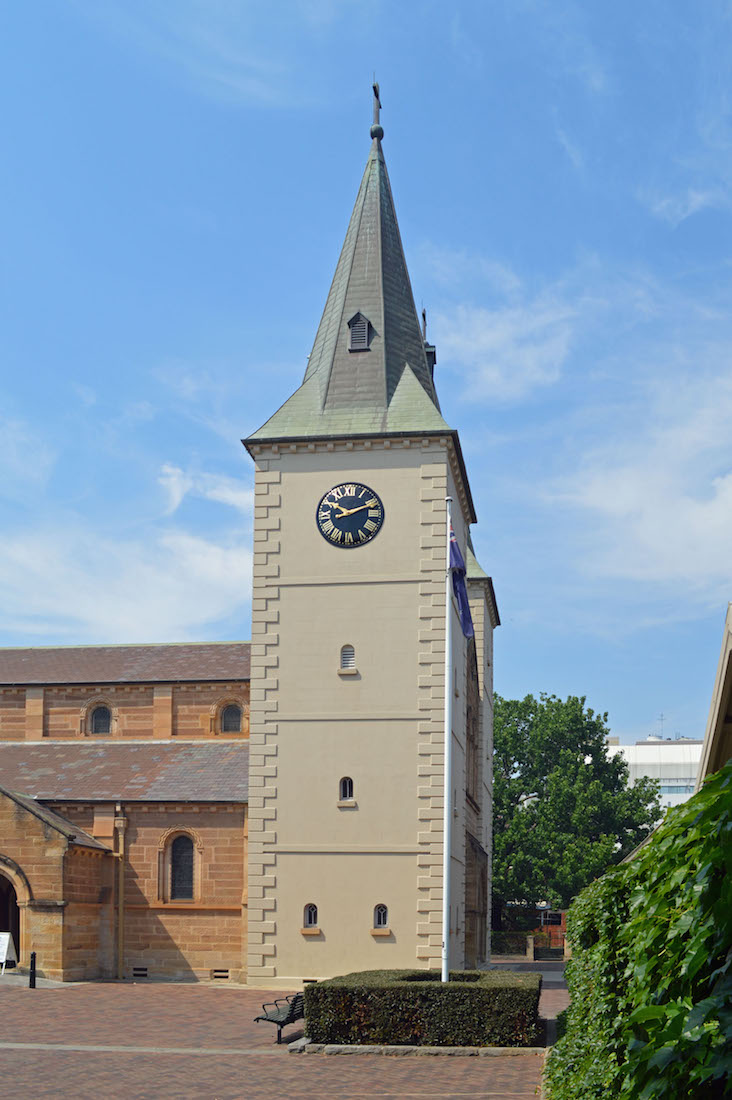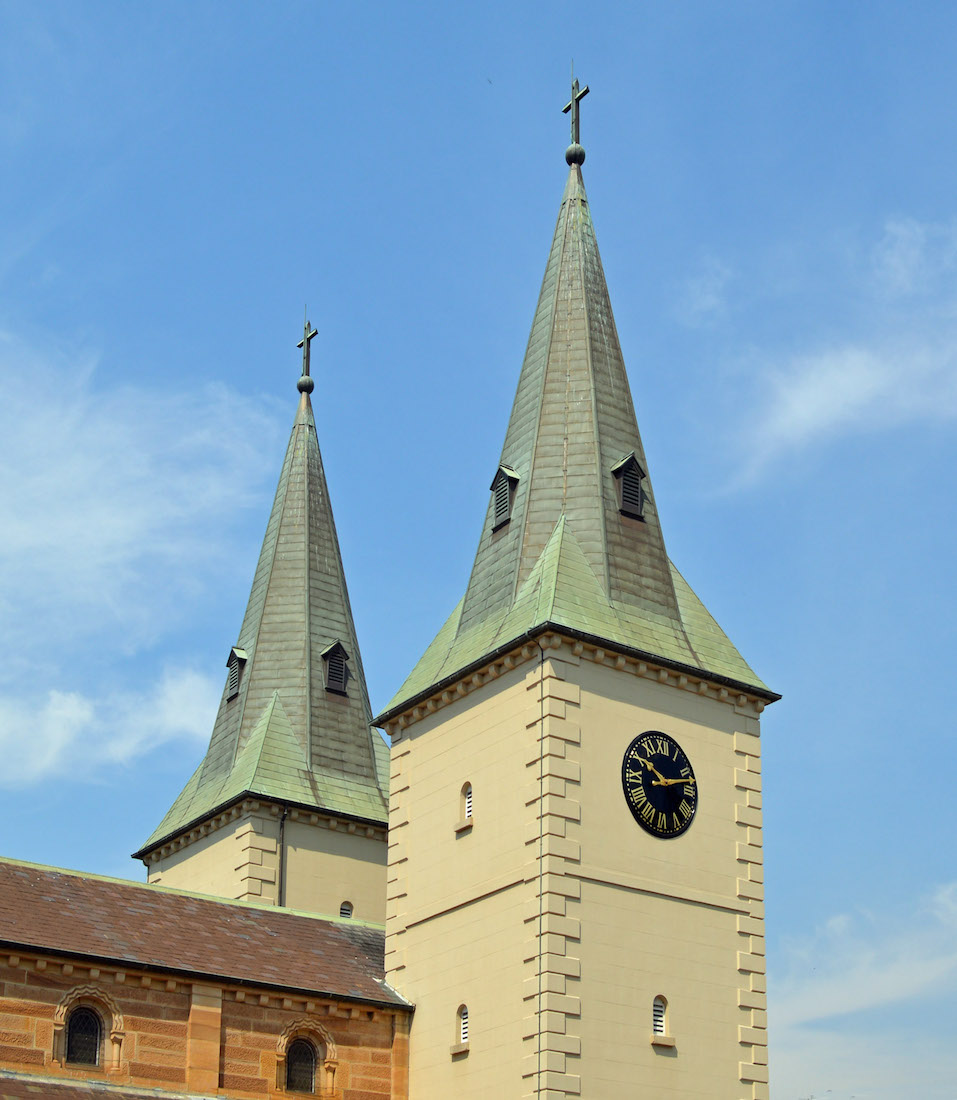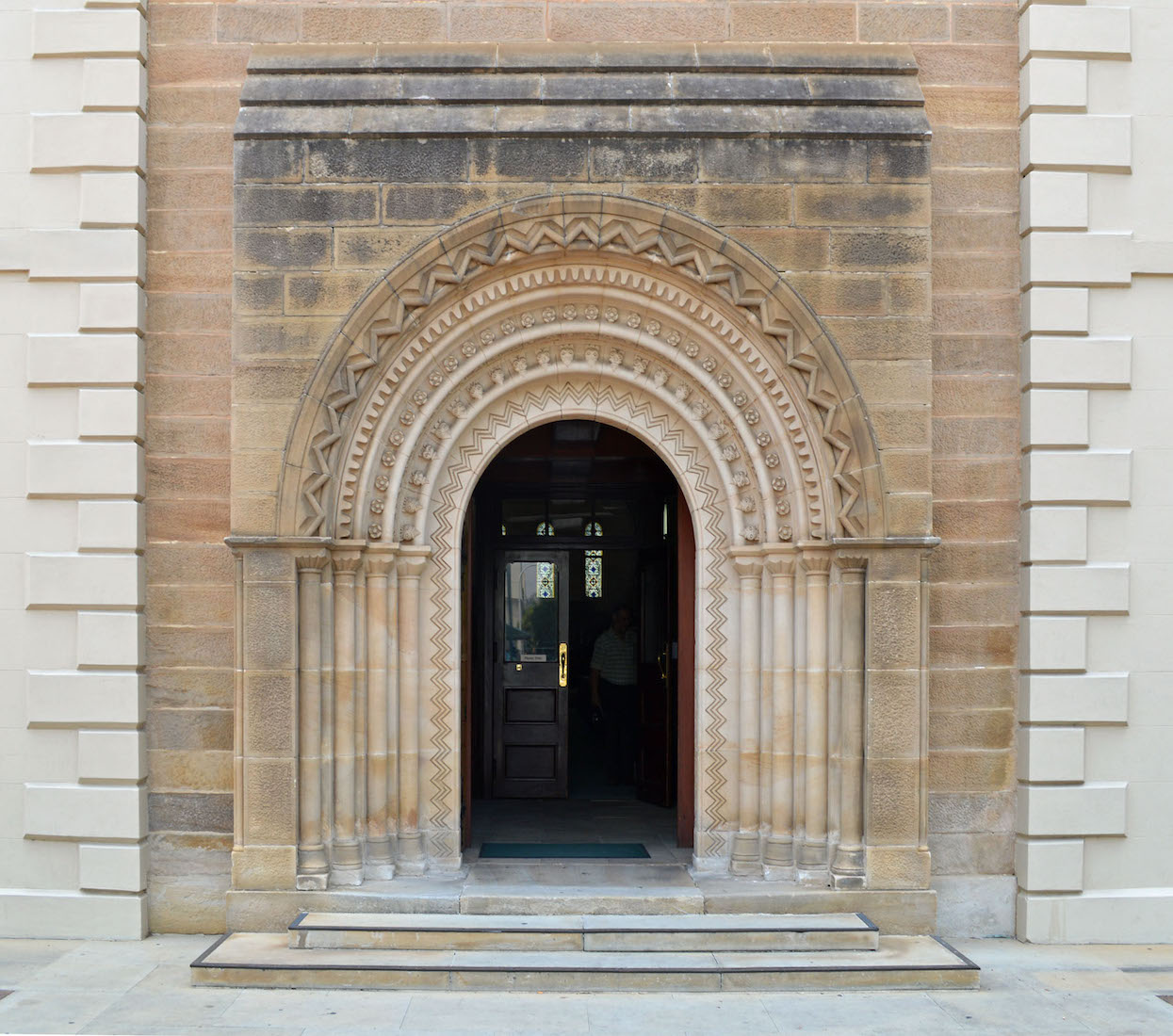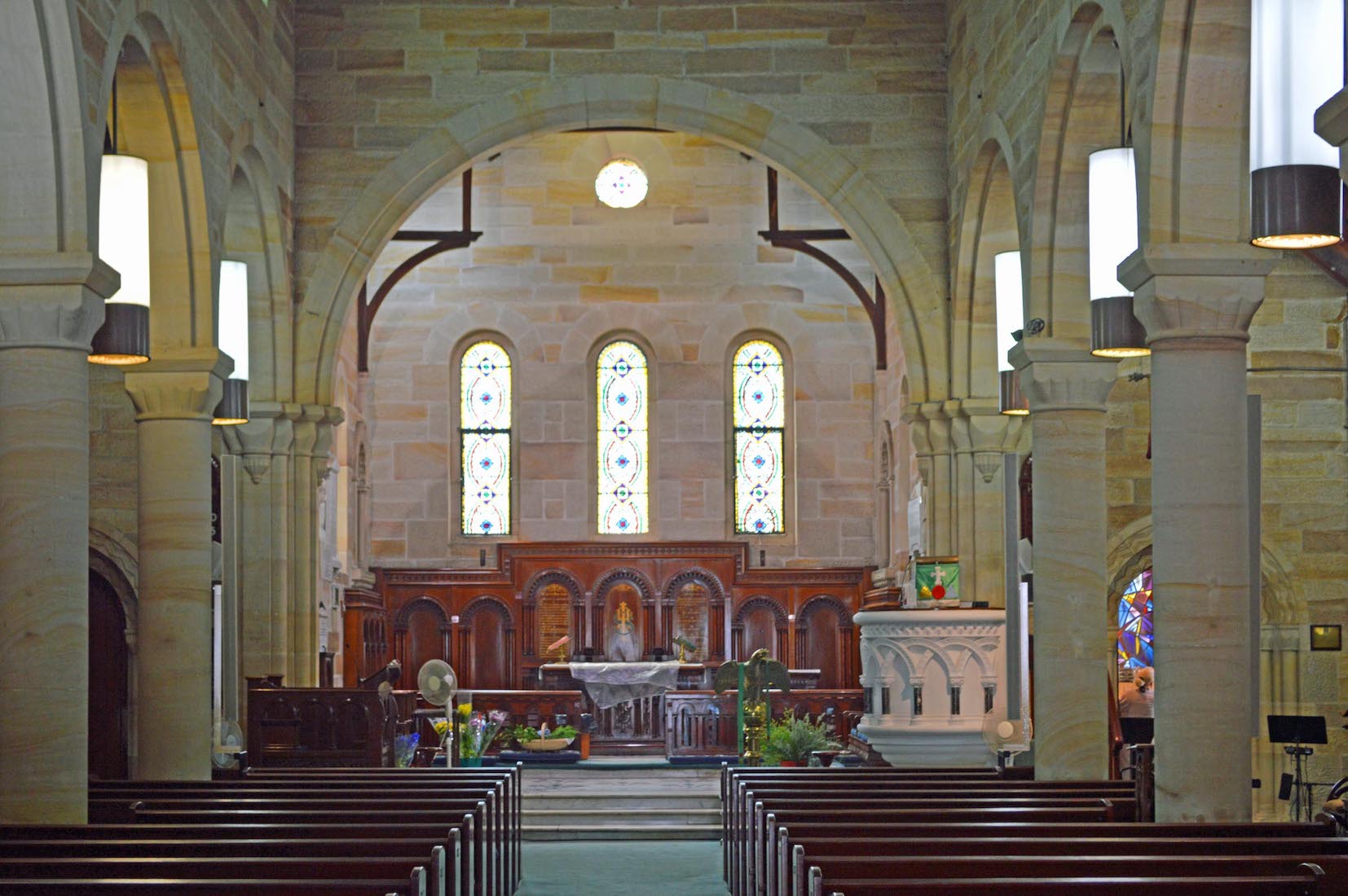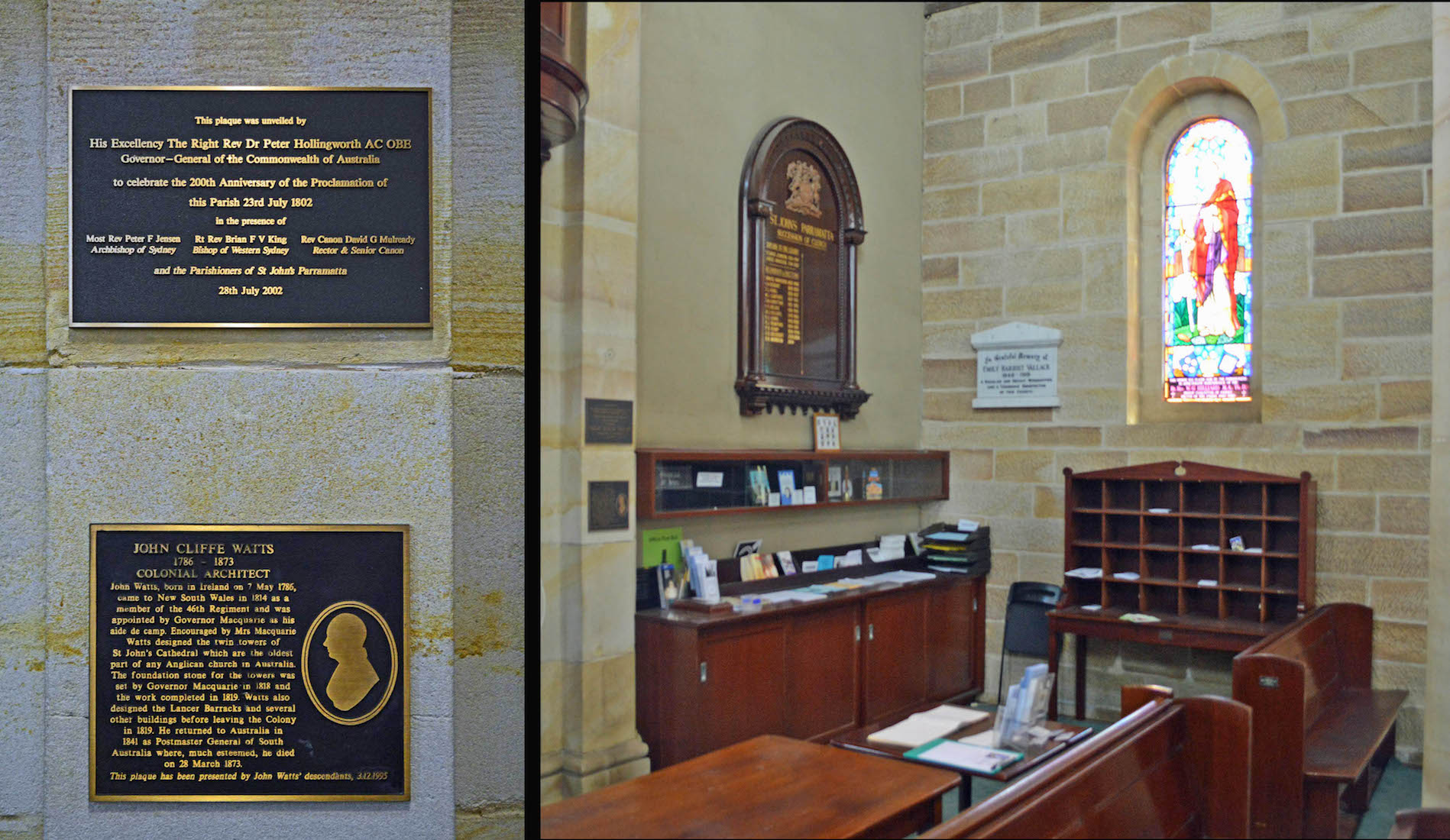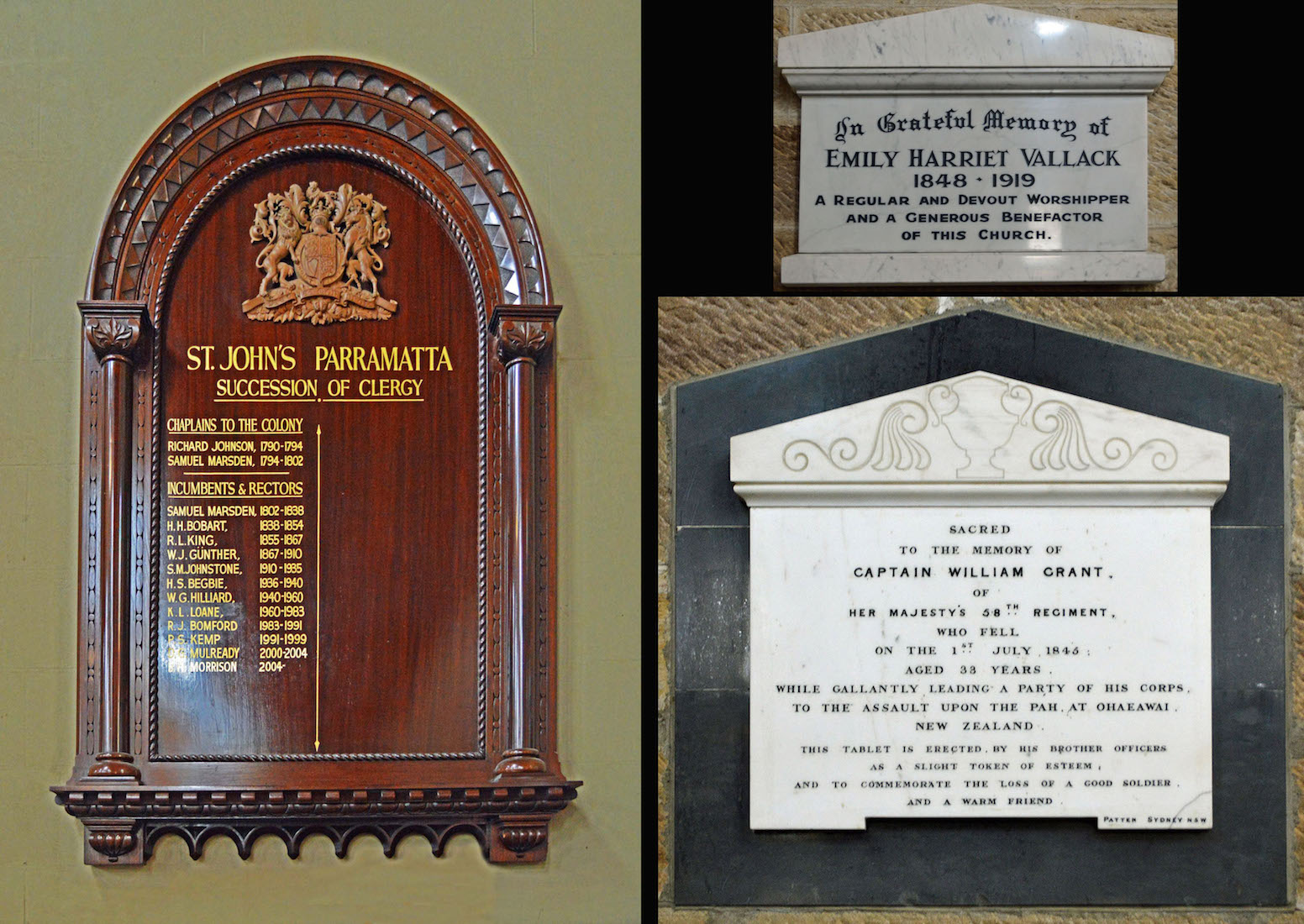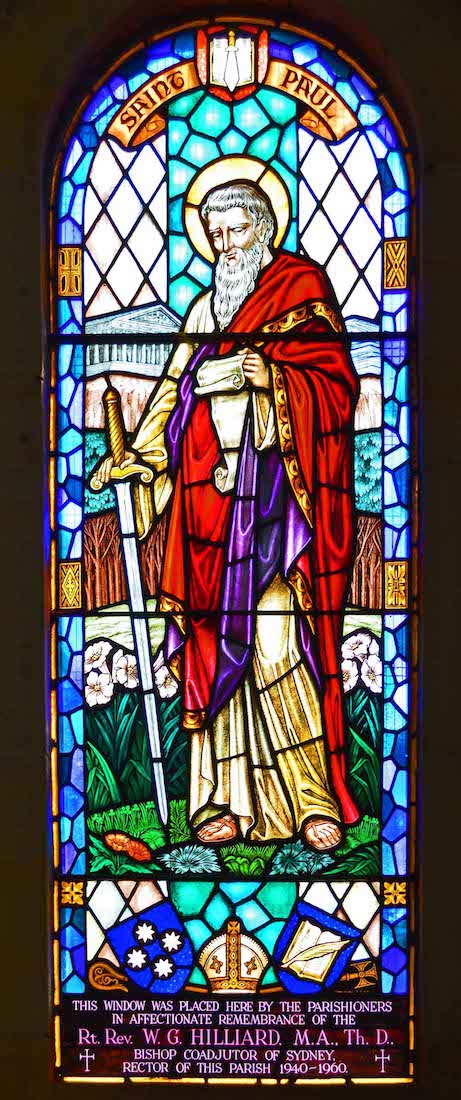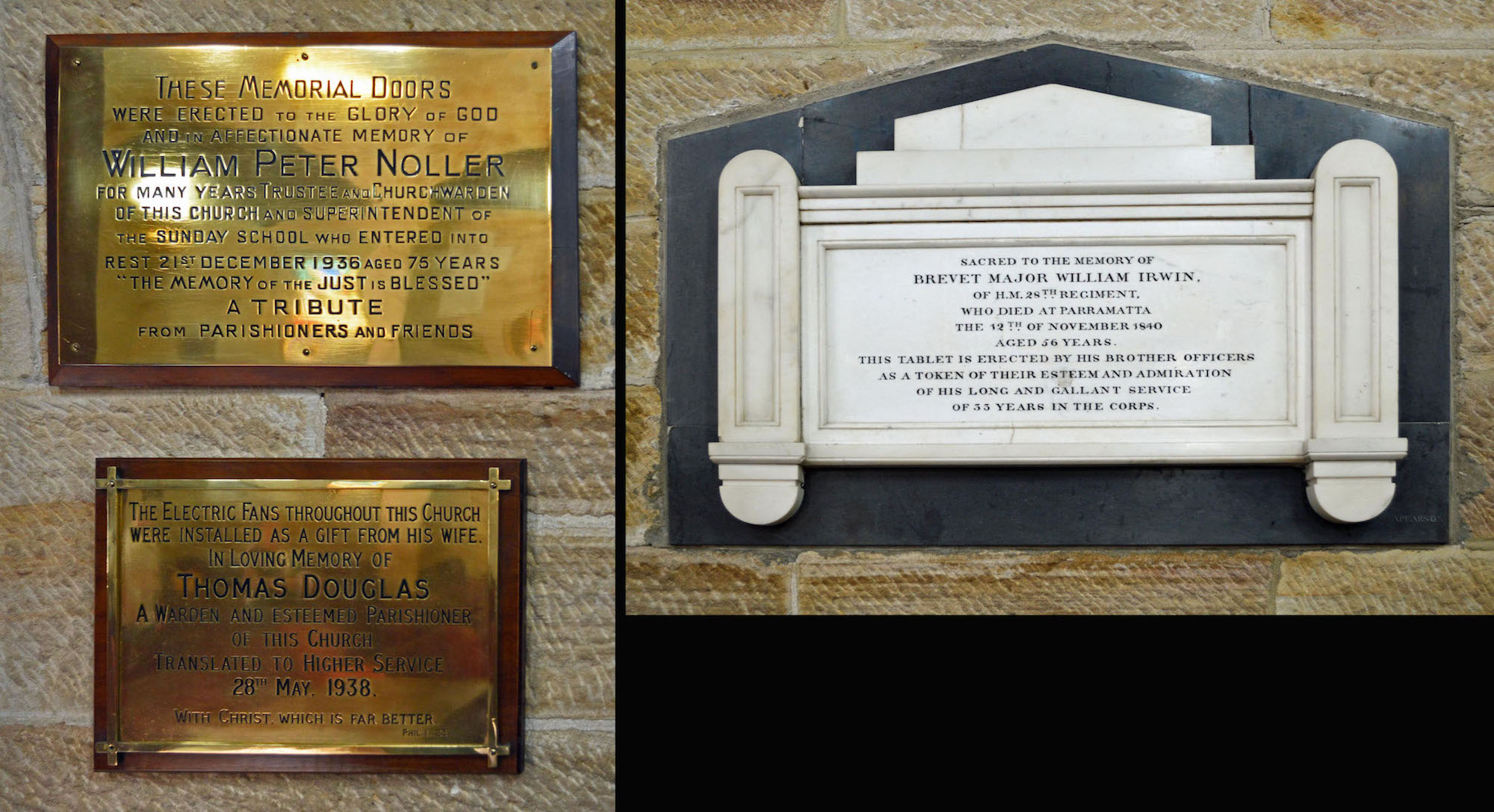
This satellite view shows St John’s Cathedral in its beautiful park setting, bounded by the railway and Church Street, and with Hunter Street to the West. The cathedral is close to having its geographical directions the same as its liturgical directions (with the East wall almost facing east), so this will cause no problems. The Cathedral is cruciform in shape with twin towers at the Western end, and two entryways at the Eastern end, just East of the transepts. The present building is the second church on this site, mostly dating from 1852, although the twin towers date from 1818. PLAN
2. SOUTH WALL
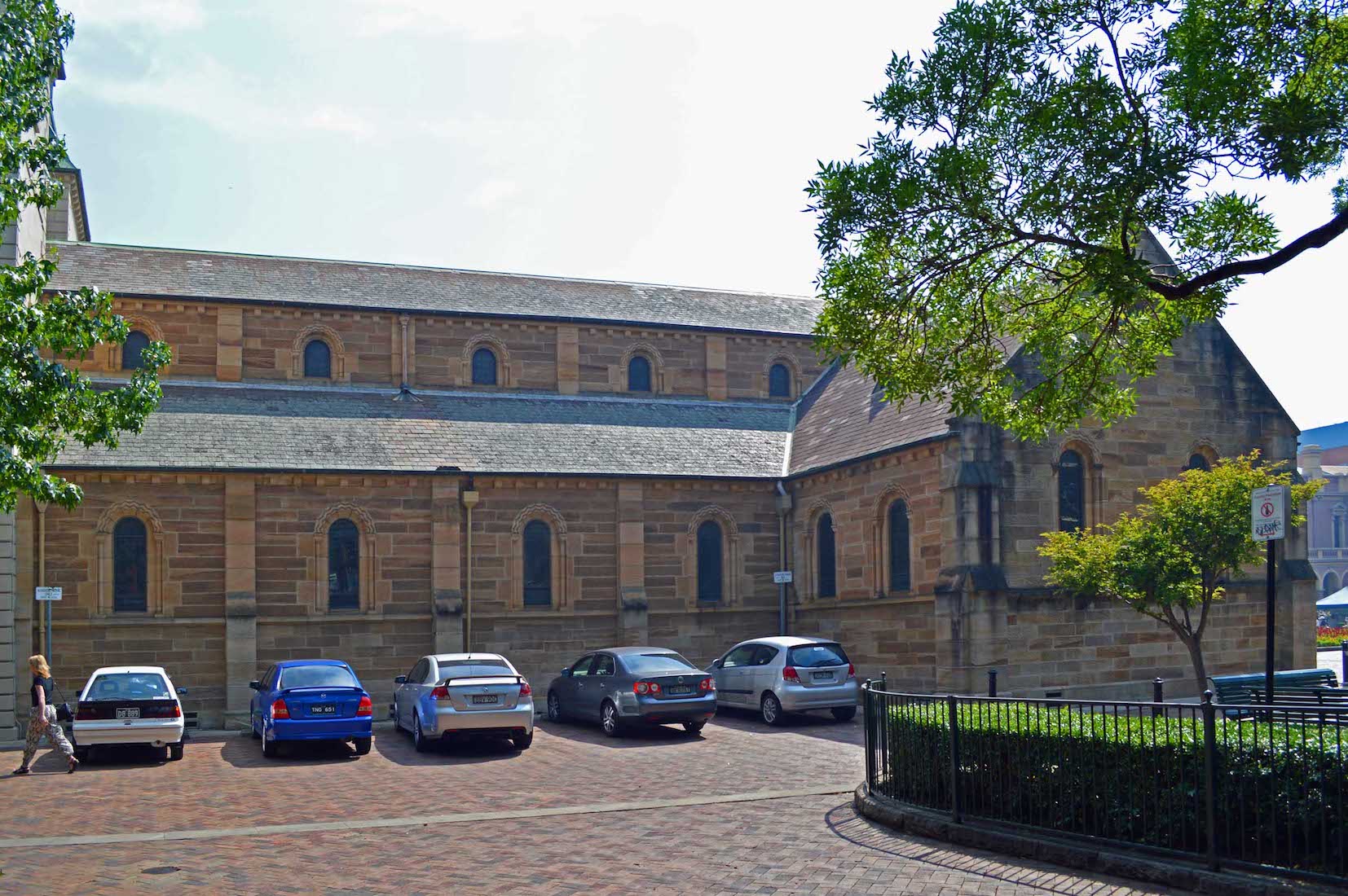
We begin our tour around the Cathedral with the South wall – not very inspiring, especially in shadow! The Cathedral is constructed from local sandstone in the Romanesque style. This is shown in the round-headed windows, and in fact, as we shall see, in the round arches and columns in the nave. We note here the lower windows and the clerestory windows, all single units, so there is an absence of the tracery found where multiple lights are joined into a united set.
3. SOUTH TRANSEPT
The walls of the nave are supported by regular solid buttresses, and we see them again here at the corners of the South transept. As mentioned before, there is no large feature window in the South transept wall, although there is a small circular top window. Crosses adorn the ends of the main gables of the Cathedral, but the roof line of each transept ends in a wrought iron finial.
4. SOUTH EAST VIEW
What a delightful setting this cathedral has, especially in spring with the colourful jacarandas! This view shows the South-Eastern entry porch, and I am interested in the triangular roofed section just beyond it. It would have been more natural to carry the transept gable roof line straight back to the nave wall, and the existing construction is not evident from within the Cathedral. I assume there is a strengthening, supporting role played by this section of wall.
5. NORTH EAST VIEW
The view of the Cathedral from the North East is similar, but without the pleasing foreground vegetation. We notice that the East wall contains three of the rounded windows, and that the sanctuary is further lit by a single window on each side. The two transepts were added in 1882.
6. NORTH EAST DOORWAY
This close up view of the North East entry shows the delightful decoration of the arches surmounting doors and windows.
7. PARK PLAQUE
The plaque is to be found in the park, a little distance from the cathedral in the North East direction. It reads: ‘On this site was erected the original St John’s Church, Parramatta. It was opened for public worship by the Rev Samuel Marsden on 10th April 1803. From then and until 1809 it was the only church building in the colony, and this site is therefore the oldest continuous church site in Australia.’
8. NORTH TRANSEPT
The North transept houses the Cathedral organ.
9. NORTH TRANSEPT GABLE
Like the South transept, this transept has a wrought iron finial at its apex, and is decorated with the restrained but attractive decoration found elsewhere in this building.
10. NORTH WALL
At the right of this view of the North wall we see one of the twin towers, and the cathedral clock. The clock was built by the London Clockmaking Company Thwaites and Reed of Clerkenwell, and installed in 1821. The clock, together with its hourly chimes, played an important role in the early development of Parramatta. For many years it was the only public clock in the Town Centre when, for most colonists of the time, the owning of a pocket watch or a clock was a luxury they were unable to afford.
11. NORTH WEST TOWER
By far the oldest part of St John’s building is the beautiful twin towers facing Hunter Street. Construction commenced on these towers under the supervision of Lieutenant John Watts in 1818. They were built by convicts with handmade sandstock bricks. The outside of the towers is overlaid with cement render, giving them the appearance of stone. The ground floor room of each tower is set aside as a vestry.
12. SPIRES
The twin towers are capped by graceful spires.
13. WEST WALL
The St John’s twin towers are the oldest surviving part of any Anglican church in Australia. It is understood they were inspired by the wife of Governor Lachlan Macquarie who had observed the Reculver Towers (variously known as ‘the two brothers’ or ‘the twin sisters’) of the 12th century rebuilt St Mary’s Saxon Church in Kent, England. Considering this belief, St John’s negotiated with the English Heritage Commission for Historical Buildings and Monuments who agreed to make available a small piece of stone from the Reculver Towers. This is mounted on the interior Western wall of the cathedral.
14. WEST DOOR
We now enter through this beautiful Western doorway.
15. NAVE
We have arrived just when the flowers are being arranged for Sunday service! The cathedral is striking for its simplicity. Rows of Romanesque arches line the nave, and a large arch of the same style frames the sanctuary. We observe the prayer desk at left and the white pulpit at right. Behind the central altar are three decorated wooden panels, with further panelling on either side. At right we have a glimpse of the stained glass window in the South East porch.
16. NORTH WEST CORNER
We begin our investigation of the interior of the cathedral by turning left. This is obviously a utilitarian section! On the walls are a roll of names, a white memorial (one of a large number of memorials and plaques), and a stained glass window. The pillar at left bears two plaques. The top one celebrates the 200th Anniversary of the Proclamation of this Parish 23rd July 1802. The lower plaque tells of the Colonial Architect, John Cliffe Watts, 1786 – 1873. Watts was an Irishman appointed as aide de camp to Governor Macquarie. Watts designed the twin towers. The foundation stone for the towers was set by Governor Macquarie in 1818.
17. BOARD AND PLAQUES
The roll board has some interesting early names: Chaplains to the Colony – Richard Johnson 1790 – 1794, Samuel Marsden 1794 – 1802; Incumbents and Rectors – Samuel Marsden 1802 – 1838, ... . The nearby plaque remembers Emily Harriet Vallack 1848 – 1919 who worshipped here and was a generous benefactor. East of the window is a plaque to the memory of Captain Wiliam Grant of Her Majesty’s 58th Regiment who fell on the 1st July 1845 aged 33 years, while gallantly leading a party of his Corps to the assault upon the Pah at Ohaeawai, New Zealand – a long forgotten conflict.
18. NORTH WINDOW
The Westernmost window of the North wall of the nave shows St Paul holding a sword and a scroll. The scroll represents his New Testament writings. The sword either represents the Holy Spirit (‘the sword of the Spirit’, Ephesians 6:17), or is a reminder of his death (Christian tradition has it that he was executed by the sword). The window was placed by the parishioners in affectionate remembrance of the Rt Rev W G Hillard M.A. Th. D., Bishop Coadjutor of Sydney, Rector of this Parish 1940 – 1960.
19. NORTH NAVE WALL
Passing the North entry, we look along the North wall of the nave towards the North transept. There are a great number of plaques and memorials in this cathedral. Some of these are only of local interest, but because of the great age of this church (by Australian standards!), there are names here of people who were important in the history and development of NSW and Australia.
20. NORTH WALL PLAQUES
The brass plaques at left acknowledge gifts to the church. The men remembered are William Peter Noller who was a trustee and warden of this church for many years, and Thomas Douglas who was a warden and esteemed parishioner here. The tablet at right is in memory of Brevet Major William Irwin of H. M. 28th Regiment who died at Parramatta in 1840 at age 56. An old timer!


